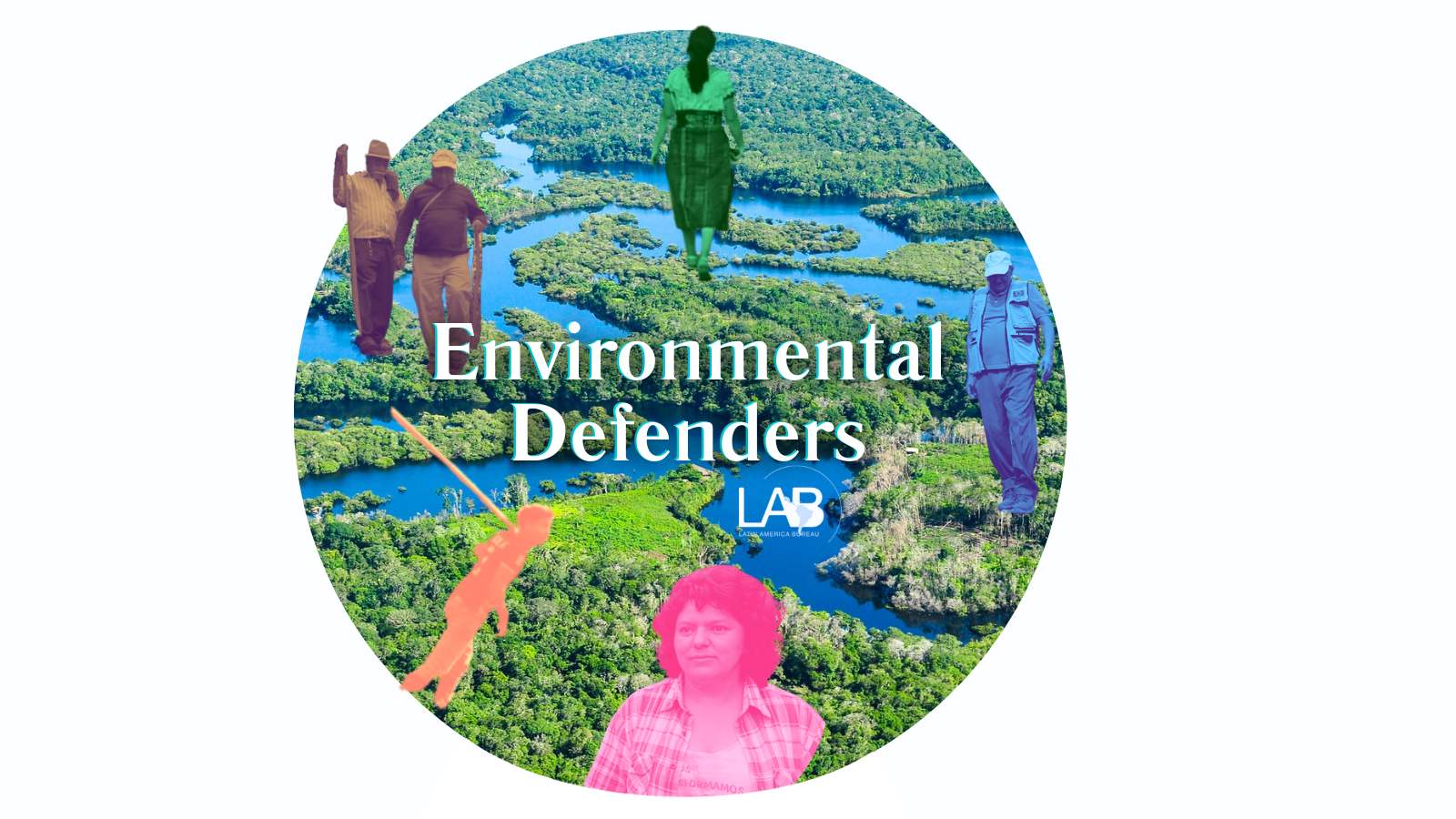- In this third article on Ecuadorean environmental defenders, Linda Etchart describes what happened when large mining company TerraEarth withdrew, at least partially, from its gold mining operations in Ecuador’s Napo province.
- The first article of the series dealt with resistance to the expansion of Petroecuador’s oil fields in Dureno, half an hour to the east of Lago Agrio, in Sucumbíos, Ecuador, and events leading up to the assassination of indigenous environment defender Eduardo Mendua.
- The second article explained how Chinese company TerraEarth obtained initial permission to mine for gold in the Napo area and the partial victory of The Frente Nacional Anti-minero in securing court rulings halting their operations or requiring action to mitigate harmful impacts and restore damaged land and water courses.
- The series will conclude by examining the ways in which Northern and Southern governments, banks, auditors and regulatory agencies, have until now failed to fulfil their promises to comply with laws and regulations, creating the conditions in which criminality is enabled rather than controlled.
When Terra Earth withdrew, the illegal miners moved on to the Jatunyaku river
The temporary suspension of TerraEarth’s legally contracted operations in Napo province after October 2020 (see previous article) appears to have inadvertently opened the door to illegal mining, from which the company may or may not have benefited.
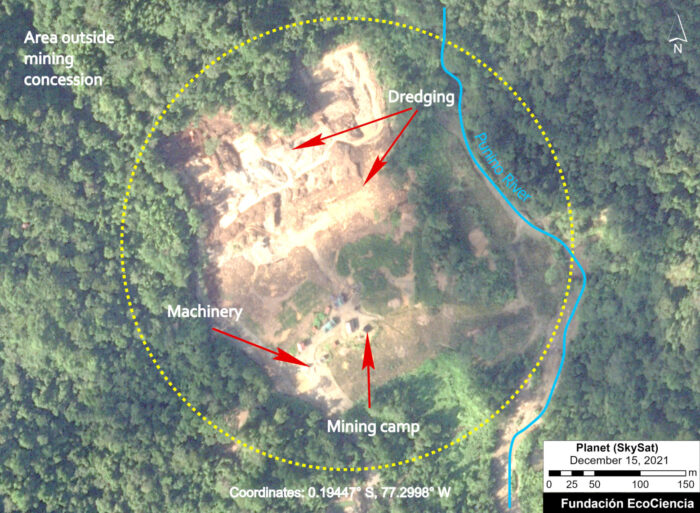
Reports and photographic evidence that emerged from the area indicated that once the word was out that gold was available for mining, actors from outside appeared. So-called ‘artisanal’ and small-scale miners came into the area, some from other provinces, to take part in a goldrush similar to that experienced further north in the province of Sucumbíos on the Aguarico river, which began in 2018, affecting the Cayambe Coca National Park and the Cofán people.
The invasion of the yellow excavators
The Napo mining frenzy took off in June 2021, when a Colombian miner brought in an excavator and found 1.5 kilos of gold. It was not clear to observers at the time where the excavators came from. Within four months, there were more than 100 excavators operating over an area of 70 hectares. Those behind the hiring of the excavators used middle-men who operated on their behalf: the profiteers remained in the shadows.
It was reported that some of the machinery and equipment belonged to local government; one of the local prefects, and the brother of a local mayor, were allegedly involved, as well as the governor. Local government trucks were seen providing diesel for the excavators. In the early stages, local family leaders were apparently charging each machine operator US$500 to operate in the zone, a fee which rose to US$2,000. That was for working in the daytime. At night, ever greater numbers of small-scale ‘miners’ arrived to pan for gold, for which they were charged US$1 dollar per night.
By the end of this period, there were 2,000–3,000 miners working in the daytime; at night, there were up to 5,000. They worked for up to eight hours at a stretch, knee-deep in water, hoping to get lucky, often going home empty-handed. It is important to distinguish legally authorised ‘ancestral’ alluvial gold-panners, who do not use mercury, from the so-called ‘artisanal’ and ‘small-scale’ miners who come in from outside the area and who do use mercury.
Why did the government delay action against the illegal miners?
It was surprising to protestors on the ground that the highly visible excavators were allowed to continue operating illegally for so long on the Napo river. There are documents demonstrating that TerraEarth had informed central government of the illegal mining in July 2021; they issued further reports in November and December 2021, and again in January and February 2022, including naming some of the perpetrators.
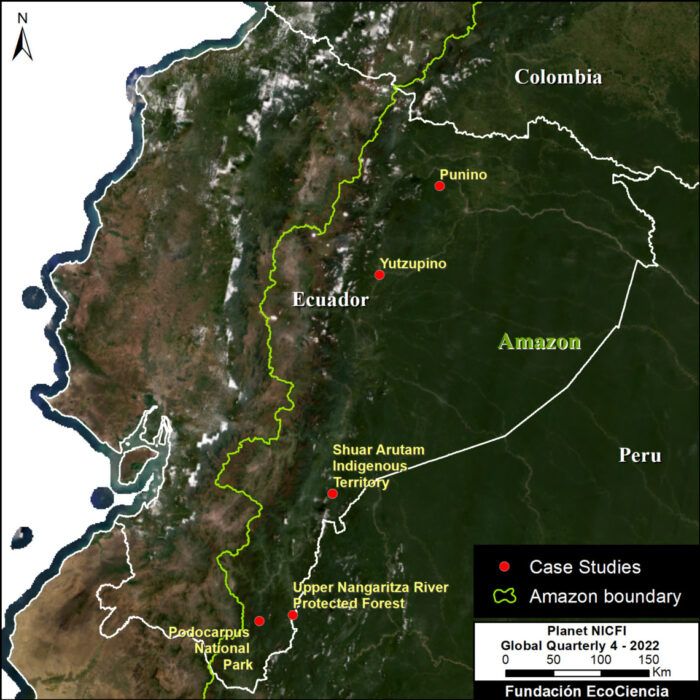
The various claims of Napo Resiste and TerraEarth in 2021 were investigated by the Monitoring of the Andean Amazon Project (MAAP). Through satellite imagery, MAAP documented mining expansion in the Yutzupino area between October 2021 and January 2022, on the Jatunyacu River, most of it having occurred in December 2021. TerraEarth denied that they were responsible.
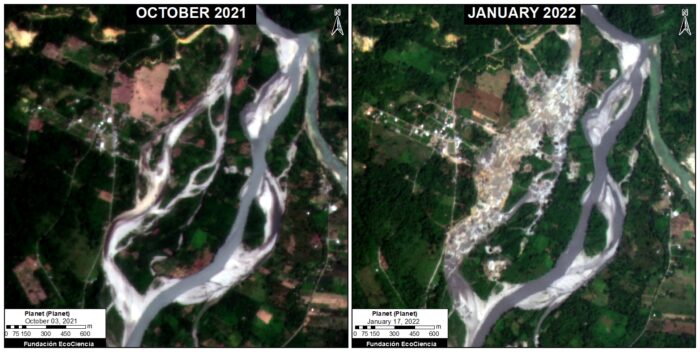
MAAP also recorded images of another mining project further north on the Punino River, located between the provinces of Napo and Orellana (see MAAP map above), where it was evident that almost half of the area cleared and excavated for a legal gold mining project was outside the legal limits. MAAP reported that on the tributaries of the Punino River, illegal mining increased by 578 per cent in 2022.
The government finally took action on the Punino River in May 2023, sending in troops who decommissioned 34 illegally operating excavators. They arrested two machine operators, impounded vehicles, including two stolen motorcycles. Some of the equipment was destroyed with explosions. They also found weapons and ammunition.
MAAP reported that between October 2022 and February 2023, 1,660 hectares of forest (the equivalent of 2,325 football pitches) had been lost in Ecuador as a result of gold mining, most of it illegal. In the Punino area, 217 hectares of forest were lost between 2019 and 2022.
The Ministry of Environment, Water and Ecological Transition (MAATE), in a press release in January 2022, claimed that in 2021 they had conducted 144 inspections in response to reports from the public, and that they were taking action in Napo, especially in Yutzupino, against illegal mining, in coordination with the Agency for the Regulation and Control of Energy and Non-Renewable Natural Resources (ARCERNNR) and the national police.
The ministry said that they had carried out five operations in the communities of Ceibo and Yutsupino, Tena canton, El Anzu sector, Jatunyacu river, in Puerto Napo parish, between October and December 2021.
MAATE announced that they were investigating serious contraventions of the law by two foreign nationals who were found to be engaging in illegal mining activities in the area. The two individuals were placed under arrest. An inspection by MAATE, ARCERNNR and the national police of the Confluence concession on the Jatunyacu river confirmed the absence of an environmental permit.
They found fuel oil stored in the open air, changes to land use, untreated poisonous water containing sediments and other materials being discharged into the river and contaminating it.
Enforcement action was finally taken on 13 February 2022, when the government sent in 1,500 troops to clear the area. The armed contingent decommissioned 124 excavators, 79 water suction machines, 3,375 gallons of fuel, and caches of chemicals.
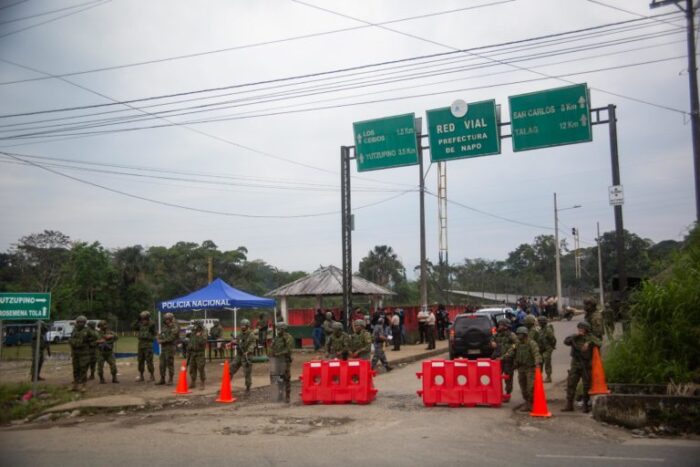
One week later, on 20 February 2022, the government ordered a moratorium on all gold mining in the province, with the Minister of Energy and Non-Renewable Resources declaring that he had never seen such environmental devastation as that caused by the illegal gold miners in the area. When the excavators began to return, however, no further action was taken. Up to 7,000 hectares of land in Napo province have already been affected, yet illegal mining continued into 2023, with no sign of further government intervention on the horizon.
The identities of the perpetrators of these large-scale illegal gold mining operations is not clear. While it is possible that TerraEarth has engaged in illegal as well as legal gold mining, as other Chinese mining companies have done in Bolivia, for example, there is ample evidence that major criminal networks associated with Colombian and Mexican narco-traffickers have been involved in illegal gold mining in Ecuador for several years, as reported by the Organization of American States in 2021, and as already acknowledged in an Ecuadorian government report on the illegal use of mercury in 2020.
The expansion of narco-mining in Ecuador
On 3 February 2023, Napo Resiste posted photographs on Instagram of the devastation caused by what they called Narcominería in Ecuador. The post stated ‘Se estima que la minería ilegal está siendo financiada por el narcotráfico, es evidente que para poder movilizar la maquinaria que se utiliza en la extracción de metales, es necesario tener gran fluidez económica.’ [We believe that illegal mining is being financed by narcotrafficking. It’s clear that in order to get hold of the machines used in mineral extraction, you need large amounts of cash.] Excavators cost around US$250,000 each, well beyond the reach of the artisanal miners. It was reported that the excavators on the Napo river had been transported in parts over the border from Colombia and then reassembled.
Figures contained in the 2021 OAS report were consistent with those from the Global Initiative against Transnational Organized Crime in 2016 that estimated that already by 2013, three-quarters of Ecuador’s gold production was being extracted illegally, a figure that is consistent with that estimated for neighbouring countries.
Corroborating the findings of the OAS report of 2021, María Eulalia Silva, president of the Ecuadorian Chamber of Mines, commented at a press conference on 26 January 2023 that the narco-traffickers had infiltrated the gold mining business in the country, and that illegal mining was taking place in 20 of Ecuador’s 24 provinces, including in national parks: ‘Narcotrafficking and illegal mining are related. They feed off each other… If the mineral supply is done in the shadows, illegally, with financing and support from narcotrafficking, it affects the stability of the region.’
Silva called upon the country’s judiciary to unite in a crusade against illegal mining. She said that security zones should be set up around the mining areas, not to violate human rights, but to protect the communities. Silva argued that these natural resources should be used for the public good, through the imposition of taxes; that the illegal miners were robbing the state, robbing all Ecuadorians. That they were operating without a social or environmental licence, with serious environmental consequences. A spokesperson for the Ecuadorian State Security Council (COSEPE) declared illegal mining as ‘a threat to the integral security of the state,’ as a part of the chain that links narcotrafficking, arms trafficking, and money laundering.
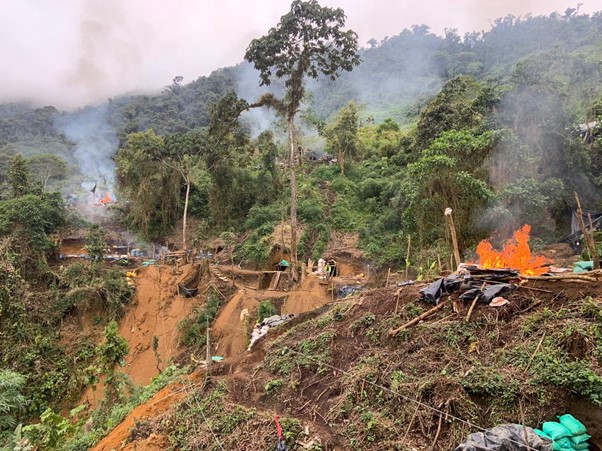
Highest external demand for gold in a decade
In Ecuador’s northern Amazon region, illegal mining increased 58 per cent between 2021 and 2022, it was reported by Mongabay, coinciding with the highest global demand for gold in a decade, with China accounting for half of that demand. But Ecuador is still not the largest producer in the region, the top two places being occupied by Mexico and Peru. Illegal gold mining is being carried out over a large part of the north and west of the continent, over an area that extends from Brazil, through Venezuela, Guyana, and Suriname, to Colombia, Peru, Chile and Bolivia. Insight Crime described illegal mining as ‘the fastest growing criminal economy’ in Latin America: former Colombian president Juan Manuel Santos commented in 2015 that criminal mining was bringing more money to criminal groups than drug trafficking.
Gold is a perfect commodity for money-laundering: it is not illegal in itself, unlike narcotics, is of high value, and can be moved from country to country to be stamped legitimate by legal operators. It is often melted, sold, and melted again, to hide its origins. ‘Clean’ gold does not exist, according to a six-part report on gold laundering published by Al Jazeera in 2023. It is not clear how much of the gold exported from Ecuador derives from Colombia and Peru, but certainly a proportion of Ecuadorian gold finds its way over the frontier into Colombia, and illegally produced gold is brought into Ecuador from Peru, according to the OAS.
Until recently gold ore was processed mainly in ‘legal’ processing plants near the mines, where it was laundered for national and international markets. In recent years, however, government efforts to prevent gold laundering have led to illegal miners and middlemen seeking alternatives to local processing.
Ecuadorian officials have reported that rather than process gold within the country, there has been a trend towards the export of unprocessed gold ore. The 2021 OAS report stated that after processed gold exports decreased, gold ore exports increased by 27,604 per cent, as measured by weight, between 2015 and 2019. According to the OAS, Ecuador exported gold ore worth US$538,633 in 2015, increasing to $100,000,000 in 2019, Ecuador becoming the world’s ninth largest exporter. The OAS also noted that Ecuador was exporting nearly four times more gold ore than Colombia and Peru combined.
The narcogarimpeiros: Ecuador main transit country for cocaine in the Americas
The dramatic expansion of illegal small- and large-scale gold mining in Ecuador has coincided with – perhaps been a cause of – the country becoming the biggest exporter of cocaine in the Americas, even though Ecuador itself is not a cocaine-producing country. Already by the early 2000s, according to Interpol, Colombian narco-traffickers linked to the Sinaloa cartel in Mexico and the ‘Ndrangheta of Calabria in Italy had been infiltrating criminal gangs and port authorities in the coastal ports of Ecuador to facilitate the export of cocaine. More recently they have become deeply involved in the illegal gold mining business, which has provided the perfect means for laundering the proceeds of the sale of narcotics worldwide.
The very large amounts of cash involved has meant that the narcogarimpeiros have been able to wield their power against the forces of law and order in a deeply divided country where Indigenous movements have challenged the monopoly power of the rich coastal elites. An already weakened conservative government under President Guillermo Lasso has come under fire following years of leaked information that has documented government officials and employees of state-owned companies accepting bribes in exchange for government contracts. Court convictions and the dismissal of the CEOs of 12 of the state’s largest enterprises in January 2023 may suggest that the judicial system continues to function, but does not necessarily restore faith in the integrity of the Lasso administration, and sets a poor example for criminals of a lesser order.
Local gangs in port cities such as Guayaquil, Esmeraldas, and Manta have been integrated into the networks of the narco-trafficking cartels who use container-truck drivers and navy personnel to transport cocaine to Mexico, the USA and to European port cities such as Rotterdam and Antwerp. The narcotraffickers have been able to convert their cash into gold within gold-producing countries such as Ecuador, and then use part of that cash to reinvest in yet more gold production. The gold has been exported via Dubai to Switzerland where it has received a legitimizing Swiss stamp. The UAE has become the world’s second largest importer of gold by volume after India, with Dubai as one of the largest gold-trading hubs.
Ecuador’s illegal gold production now qualifies for the designation ‘blood gold’, a label until recently applied only to West African and Latin American gold extracted at the cost of human lives and wellbeing, 75 per cent of which until recently was refined in Switzerland. Criticism of the failure of Swiss government oversight of gold imports, dating back at least to 2016, led the Swiss Federal Audit Office to declare in 2020 that the current system was not equipped to prevent illegal gold entering the country. Measures implemented by the Swiss government since 2020 have begun to shift imports away from Switzerland and directly to Dubai, where there is less oversight.
In the meantime, back in Ecuador, over this same period, the security situation has deteriorated. The police and the armed forces have struggled to seize contraband goods, maintain order, and arrest criminal elements within Ecuadorian society, but so far appear to be losing ground.
Guayaquil is now one of the most dangerous cities in the world
The appearance of the narco-garimpeiros in Ecuador appears to have increased levels of crime. Turf wars among local gangs in Guayaquil such as the Choneros and its splinter group Los Lobos have led to murders and kidnappings in Guayaquil, and other ports further north along the coast.
Crime is organised out of Ecuador’s overcrowded prisons, where 8,000 members of Los Lobos were housed in 2022. In 2021-2022, there was a series of prison massacres, with the death of 315 prisoners in 2021. Guayaquil has become the 26th most dangerous city in the world, with the appearance of bodies hung from bridges in the style of the hitmen in Ciudad Juárez on the US-Mexican border.
Guayaquil had the highest rise in the number of murders of any city between 2021 to 2022, with more than 25 deaths per 100,000 of the population, alongside similar crime rates in the Ecuadorian port cities of Machala, Manta, and Esmeraldas, all linked to the narcotics trade. Businesses are forced to pay protection money to the cartels; in May 2023, armed guards were deployed in the north of Guayaquil to protect university students as they entered their colleges for classes.
The failure of the security services and the police to halt illegal mining, therefore, should be viewed alongside Ecuador’s current predicament of social and political breakdown, with the added problem of the infiltration of public and private institutions by criminal operatives, and government employees’ vulnerability to incentives, extortion and threats.
Within this scenario of the security services being stretched to their limits, anti-mining activists, frequently under threat of violence, now fear for their lives. Leonardo Cerda, one of the leaders of the Napo Resiste movement in Tena, has now joined those at risk. In an exclusive interview with Latin America Bureau in February 2023, Cerda condemned the lack of government action in preventing illegal gold mining in his hometown, and its failure to protect Ecuador’s environmental defenders. Cerda has received threats from paramilitary groups: a plain-clothed posse came to kidnap him in January 2023, identified only by their government-owned car. The presence of a group of associates prevented his capture. This is not the first time that Ecuadorian environmental defenders in Ecuador have been attacked or threatened.
In an interview with LAB on 13 April 2023, Napo Resiste leader Majo Andrade Cerda, also from the community of Serena, in Napo province, indicated that she, too, is risking her own safety in her attempts to protect the Amazon rainforest from the damage caused by gold mining. ‘The fear is constant’, she said, just before leaving her hometown to participate in the United Nations Permanent Forum on Indigenous Issues (UNPFII) in New York. ‘We are constantly threatened. We never know when they will be angry with us. They attempt to intimidate us.’
Andrade explained that even though the courts had ruled in their favour, and against the gold miners, the government had neither the will nor the capacity to remove the gold miners. She said that the police were not interested in protecting individuals, but in protecting the state. Andrade pointed out that while the government announces that it respects the Indigenous and local communities and says that it is committed to protect the Rights of Nature in Ecuador, in practice it is continuing to grant concessions to mineral and oil companies to mine and drill in Indigenous territories. She said, ‘Why would they want to protect us, when we are the ones who criticize them?’
Not only does the government lack the budget and resources to address the problem, its agents also demonstrate a lack of will to act when an opportunity arises to catch miners red-handed. Andrade expressed frustration at the lack of coordination among the various elements of the local government bureaucracy and law enforcement agents:
‘The Ministry of the Environment ask me to give them exact locations, exact GPS coordinates of where the illegal excavating is taking place. So, for example, if today 13 April, they get a message from us telling them that the excavators are in such and such a place, and we tell them exactly where… they won’t act on the message until tomorrow, as first they have to alert the Environmental Enforcement Department, who will inform the environmental police, who will mobilize the military. All this takes three or four days of to-and-fro within the ministry, so precious time is lost. Meanwhile, of course, the illegal miners have been tipped off, the information filters out to them, because there is corruption. When the authorities finally arrive to carry out an inspection, the machines will have vanished.’ ‘Cuando llegan, ya no están lavando, no están haciendo lo mismo. El gran problema es eso, la corrupción y la burocracia.’ [‘When they [the authorities] arrive, they [the miners] are no longer sluicing for gold, they’re not doing any of that. That is the main problem, corruption and bureaucracy.’]
Linda Etchart is a lecturer in Human Geography at Kingston University. She is regular contributor to Latin America Bureau, and author of Global Governance of the Environment, the Rights of Nature and Indigenous Peoples: Extractive Industries in the Ecuadorian Amazon. New York: Palgrave Macmillan.
Main Image: Gold excavators moved from iYutzupino to Chonta Punta, ecuador. Image: Prensa Minera.
Sources and further reading:
Etchart, Linda (2022.1) “Financing for Development: Extra-Official Payments as Incentives for Development Projects.” Chapter 11, in Etchart, L. (2022) Global Governance of the Environment, Indigenous Peoples and the Rights of Nature: Extractive Industries in the Ecuadorian Amazon. London: Palgrave
Etchart, Linda (2022.2) “Indigenous Peoples and International Law in the Ecuadorian Amazon.” Laws 11, No. 4: 55.
Gabay, Aimée (2022) “Gold rush in Ecuador’s Amazon region threatens 1,500 communities.” Mongabay, 11 March 2022.
Gatehouse, Tom (2023) The Heart of Our Earth: Community resistance to mining in Latin America. Practical Action/Latin America Bureau.
Insight Crime. All About Ecuador.
Insight Crime (2022) Legal frameworks to protect the Amazon are being sorely tested. Insight Crime. 8 November.
Jones, Katie, et al. (2022) “Beneath the surface of illegal gold mining in the Amazon.” Insight Crime. 8 November.
Klein, David (2022) “Interpol: Illegal gold mining is devastating Latin America.” OCCRP. 6 May.
Mestanza Ramón, Carlos, Jefferson Cuenca-Cumbicus, Giovanni D’Orio, Jeniffer Flores-Toala, Susana Segovia-Cáceres, Amanda Bonilla-Bonilla, and Salvatore Straface (2022). “Gold Mining in the Amazon Region of Ecuador: History and a Review of Its Socio-Environmental Impacts.” Land 11: 221.
Organization of American States (OAS) (2021) Secretariat for Multidimensional Security. Department against Transnational Organized Crime. On the Trail of Illicit Gold Proceeds: Strengthening the Fight Against Illegal Mining Finance, Ecuador’s Case.
Organization of American States (OAS). Secretariat for Multidimensional Security. Department against Transnational Organized Crime. On the trail of illicit gold proceeds: strengthening the fight against illegal mining finances : Peru’s case.
Pelcastre, Julieta (2023) “OAS: Illegal Gold Trade from Ecuador to China on the Rise.”
Periodismo de Investigación (pi) (2022) “Minería ilegal en Napo: Se llevaron el oro mientras sembraban un cementerio: El río Yutzupino murió por causa de la minería ilegal y la tapiñada minería legal.” February 26.
Pieth, Mark (2023) “Delving into the shady world of gold laundering.” Corruptionwatch.


